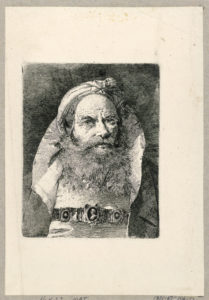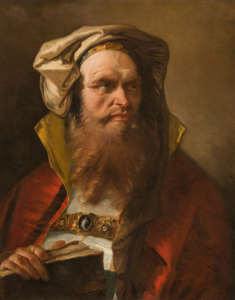Object of the Month: August 2021
A Philosopher Holding a Book
Oil on canvas
Giambattista Tiepolo
Venetian, 1696–1770
One of the latest Italian painters represented in the Museum & Gallery Collection is the greatest artist of 18th-century Venice, Giambattista Tiepolo. While Tiepolo achieved most of his fame through breathtakingly airy frescoes on the ceilings of palaces, churches, and villas, he also revived age-old themes from the Bible and antiquity through fresh interpretations. Such is the case with a series of bust-length portraits of bearded old men, begun perhaps as early as the 1740s. These men in oriental garb are widely regarded as a series of ancient philosophers, but no definite case may be made for the group since most lack traditional attributes. Tiepolo was certainly influenced by Rembrandt’s paintings of bearded old men which may also be perceived as simple character studies.
 The present painting is the original treatment by Tiepolo that together with others from the series was later copied by his artist sons, Domenico and Lorenzo, in etchings called La Raccolta de Teste (The Collection of Heads). The vigorous brushwork, vibrant colors, elaborate dress, and penetrating gaze of the sitter combine to make M&G’s Philosopher Holding a Book an excellent example of Tiepolo’s lesser-known skills at small-scale work. The etching to the left is made by Giovanni’s son as a copy of his father’s work. These smaller versions usually omit the hands, but the cloak clasp is included.
The present painting is the original treatment by Tiepolo that together with others from the series was later copied by his artist sons, Domenico and Lorenzo, in etchings called La Raccolta de Teste (The Collection of Heads). The vigorous brushwork, vibrant colors, elaborate dress, and penetrating gaze of the sitter combine to make M&G’s Philosopher Holding a Book an excellent example of Tiepolo’s lesser-known skills at small-scale work. The etching to the left is made by Giovanni’s son as a copy of his father’s work. These smaller versions usually omit the hands, but the cloak clasp is included.
One of the virtues of art that John Keats extols in his poem “Ode on a Grecian Urn” is the ability of art to ask questions of the viewer. Sometimes these questions are answerable; sometimes they aren’t. But the mystery is what draws viewers to return, allowing them to absorb more of the work as well as more of the mystery.
So, what is it that makes this seemingly straightforward portrait of a man with a book so interesting and intriguing?
- Size: The work is small, unlike most of Tiepolo’s painting, which adorns ceilings and walls of various significant buildings in Venice and elsewhere. This focused work is part of no grand scheme or storyline. The work is part of a larger collection, also unusual for the artist. While artists often had studios of apprentices, Tiepolo’s own sons copied these works as etchings, collecting them into a published book—a practice which, presumably, expanded the audience of viewers and increased greater demand for similar works. This painting is called a portrait; yet, in one sense it is not, for the emphasis is not on the sitter. This man is not a historical figure who wishes to be known to posterity; he is merely an anonymous model given a role to play as a philosopher with a book.
- Subject: Is he really a philosopher? Which philosopher is he? In the collection of twenty “heads,” only two have been identified as actual philosophers: Diogenes and Pythagoras. It has been suggested that M&G’s may be Xenophon, a Greek historian and philosopher. It has also been suggested that these “philosophers” are merely studies in physiognomy, a so-called science of identifying the character of a person through an examination of facial structure or attributes such as the set of eyes or wrinkles. Such a science was familiar to Tiepolo whose sketches illustrated a manual on the topic.
- Details: What or who are on the clasps and brooches so prevalent in the collection? Tiepolo used the motif on the clasps in other works not a part of this collection—Two Men in Oriental Costume (a large wall decoration) and the more elaborate scenes of the Scherzi di Fantasia. The cameo-like ornament adorns the turbans as well as the cloaks. Are they meant to identify the philosophers? Or simply beautiful Oriental embellishments?
All of these questions can be frustrating to art historians and viewers alike. But Keats would propose that they are an indication of good art, something beautiful that attracts further examination, pondering, and appreciation without final satisfaction. Good art pulls us out of ourselves and reminds us, like Horatio, that “there are more things in heaven and earth. . . than are dreamt of in your philosophy.” Doubtless, this philosopher with a book would have agreed.
Dr. Karen Rowe Jones, M&G board member
Citation: Print, Portrait of a Man, Plate 6, from the series Raccolta Di Teste I; Giovanni Domenico Tiepolo (Italian, 1727 – 1804); Italy; etching on white laid paper; 1931-67-106-2
Published 2021
